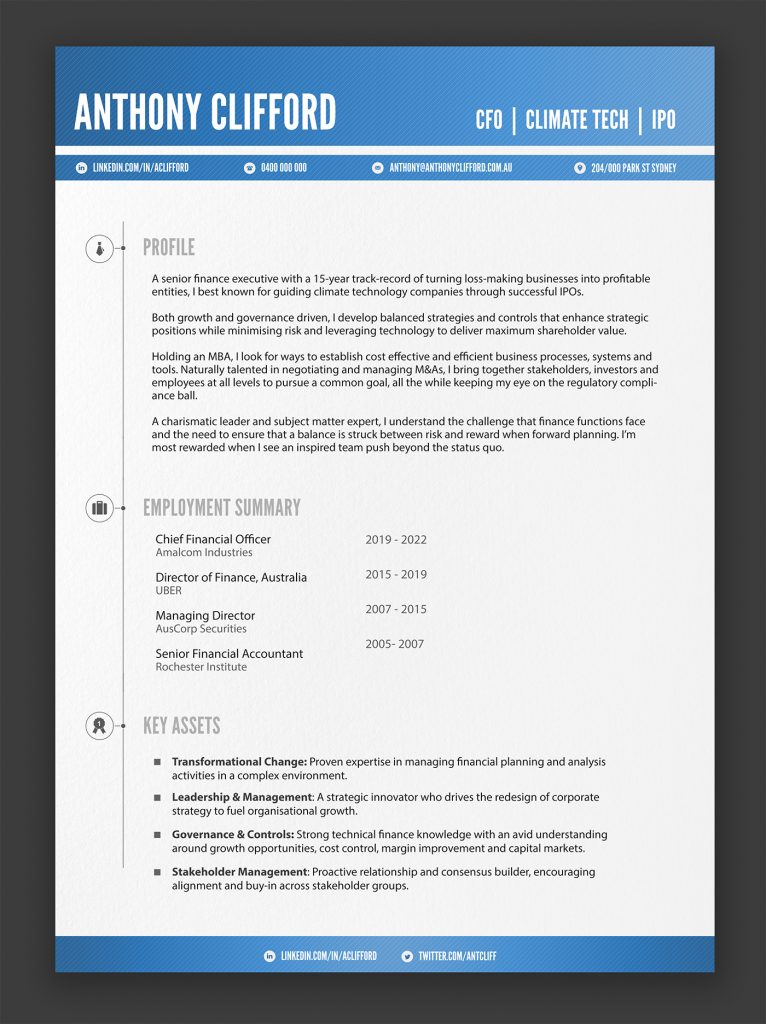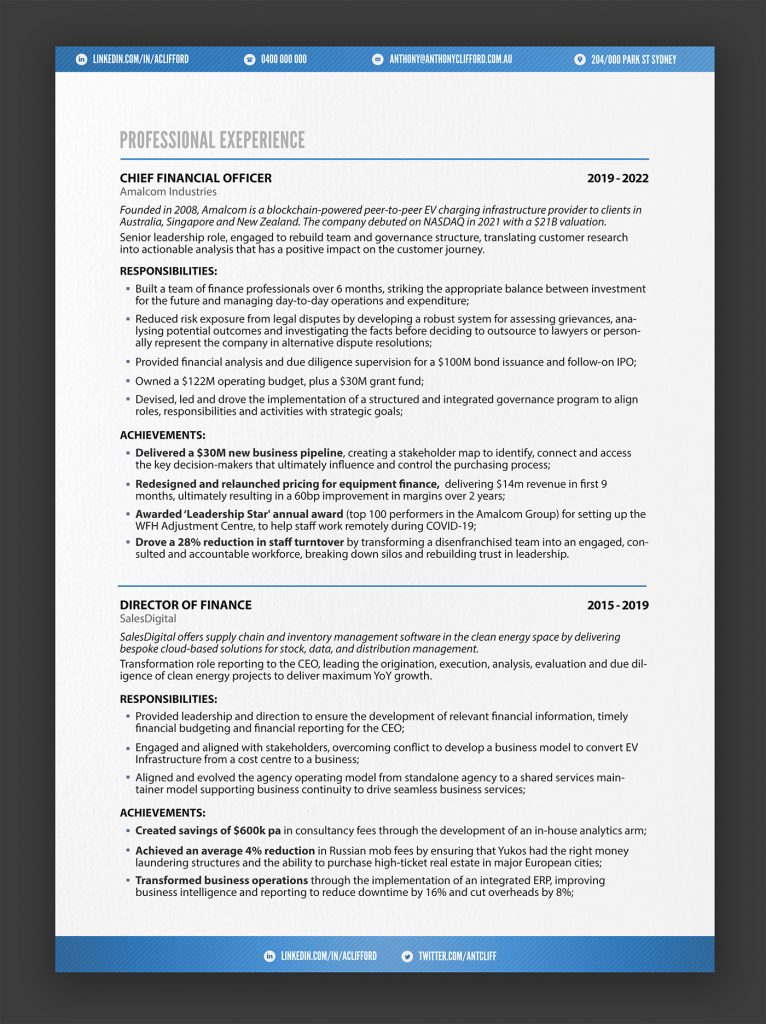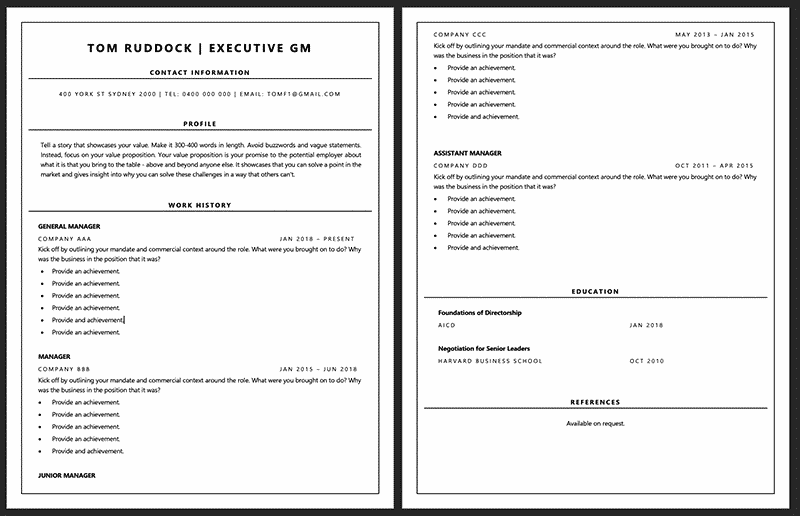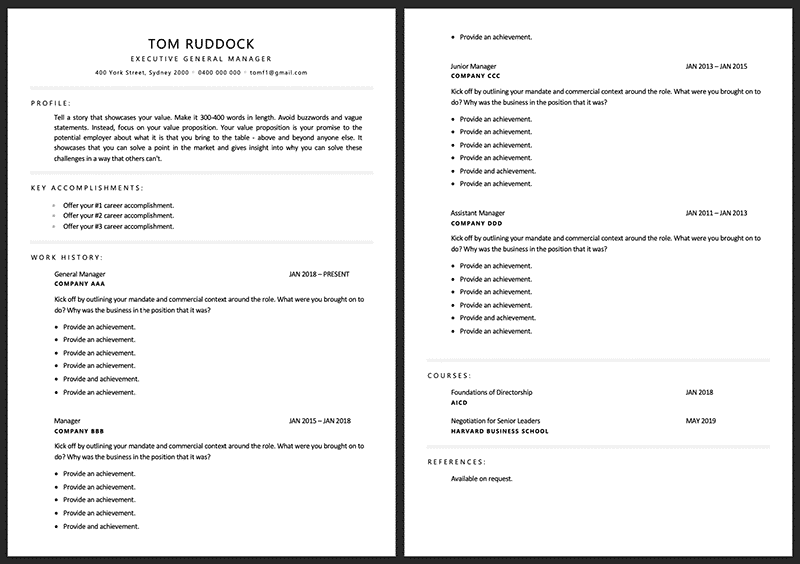Reading Time: 10 minutes Applying for a job in Australia? You'll need to ensure that your resume plays by Australian rules. Learn from my Australian resume examples - and follow my tips.
Reading Time: 10 minutesApplying for jobs in Australia can be challenging, especially if you’re not sure what the hiring process looks like, what an Australian resume should include, and if you don’t have any great Australian resume examples to learn from.
Yet, we’re at the starting blocks of 2024 – and despite the lowest unemployment in history, competition for the best Australian jobs is tough.
Below, you’ll find Australian resume examples, resume samples, templates and guidelines designed to help you meet the expectations of Australian recruiters and hiring managers.
Consider using my:
Australian Resume Examples To Get You Hired.
Let’s start with a resume example that does everything right. It’s the perfect resume for the Australian job market.

Above: Don’t be scared. You’ll be able to write a resume just like this by the time you finish this article.
In a moment, I’ll comb through this resume example page by page, explain why it’s effective and show you how to write one just like it.
(Related: Which City Has Better Job Prospects: Sydney Or Melbourne?)
What Makes Australian Resumes Different?
Australian employers look for these 6 features when deciding whether your resume warrants their attention:
Before I unpack each of these, let me share a little-known but essential nuance of Australian culture.
Important!
Knowing this secret will massively improve your chances of getting your resume noticed in the Australian job market.
How To Impress Australian Employers.
Australians are famous for their laid-back attitude. They appreciate confidence and professionalism but severely dislike arrogance and hubris.
When crafting your resume, you must position yourself as a confident and highly competent individual.
Don’t get carried away, though. Your resume should not read like it was written by Conor McGregor, for Conor McGregor.

Above: He never had a chance against Mayweather.
Aussies don’t relate well to overly brash and self-aggrandising people. (They reserve a term for them that begins with a “w” and rhymes with “tanker”).
Striking a balance is vital.
Structure Of A Great Australian Resume.
Now that you understand the cultural background that you’re dealing with let’s delve into the critical specifics of resume writing.
A perfect Australian resume begins with getting the resume format, length and design 100% right.
What’s The Ideal Resume Length?
Australian resumes vary between 2 and 5 pages in length. The exact length of your final draft will be driven by your level of seniority and the complexity of your skillset.
Should You Use The Chronological Resume Format?
No, because:
What Design Principles Must Your Resume Follow?
Keep your design clean and simple. Don’t create a fruit salad with excessive font styles, sizes and fonts.
Limit yourself to two font sizes and two font styles across the entire document.
Do You Need To Include Your Photograph?
In some countries, it’s standard practice to include your headshot at the top of your resume. Not so in Australia.
Important!
Do not include a photograph of yourself – regardless of how handsome or pretty you think you are.
What Spelling Quirks Do You Need To Be Aware Of?
A few. Replace American English with correct Australian English spelling. That’s:
This is obvious, but I need to say it anyway – triple-check spelling and grammar (read my guide to linguistic mistakes that make you look dumb).
Do Australians Expect A Specific Paper Size?
It’s HIGHLY unlikely that an employer will ask you to print your resume, but if they do, follow these rules:
Do You Need To Include Your Marital Status and DOB?
No. No need to include your race or religion, either. (Why?)
How To Structure The First Page Of Your Australian Resume.

Above: Notice the abundance of white space. I use it to create a clear hierarchy of information and a friendly, approachable feel.
The first page of your resume makes or breaks your job prospects. No pressure!
In most cases, it will contain a headline, your professional profile, employment summary and key skills. Here’s how to get them right.
1. Your Headline.
The headline on a resume typically appears under your name, and is essentially your tagline.
My advice is to match your headline with the job you are applying for. Include any certifications that add credibility and, if possible, highlight your specialisation. For example:
This is not the place to be cool, so no ‘Number Monkey’, ‘Head Honcho’ or ‘Moral Captain’ references. Please.
2. Your Profile.
Here is where you can inject some ‘colour’. Think story. Think brand. Think impact.
(Related: 25 Elements You Must Include On Your Resume).
Most candidates will use this space to detail their overarching experience, qualifications and specialisation. For example:
While that approach is reasonably effective, do one better and get to the heart of what makes you unique:
3. Your Employment Summary.
You may be familiar with the 2012 study undertaken by online job-matching service TheLadders that claimed recruiters spend an average of just 6 seconds reviewing an individual’s resume.
Using an eye-tracking technique, researchers found that recruiters focused on your name, current job title, company and dates of employment.
Important!
You must include this information on the first page of your resume – and do so in a clear and easily digestible format.
In Australia, recruiters look at your last 10-15 years of employment history. Only go back further if your earlier experience is highly relevant.
4. Your Key Skills.
Also known as “Key Assets”, this section is a condensed summary of your capabilities. It’s an opportunity to provide recruiters and hiring managers with a glimpse into your:
Importantly, resist the temptation to create a table that lists generic skills like “problem-solving”, “empathy” and “negotiation”.
Instead, follow my resume examples above to create a set of 1-2 sentence stories that showcase your most commercially relevant strengths. For example:
Or:
How To Structure The Midsection Of Your Australian Resume.

Above: Some recruiters will skip straight to this section. They want to know two things: why you were hired and what you achieved.
Here, Australian employers expect you to get into the meat of your roles.
List each of your roles in reverse chronological order, ensuring that you provide both the big picture context and tactical detail. Here are my power tips for getting it right:
Most importantly, front-load and quantify your achievements. For example:
Is much better than:
How To Structure The Last Page Of Your Australian Resume.

Above: Resist the temptation to put in less effort on the last page. Finish strong.
Well, it’s time to wrap things up.
This typically means listing your education, additional career history, professional development and references.
1. List Your Education.
To quote the great Sir John Monash, pioneering scholar, soldier and engineer who lent his name to one of Australia’s leading universities:
Australians, like most Westerners, value education and continuing professional development.
Be sure to highlight your academic and professional qualifications by including the name and major of your degree, along with the awarding institution:
There is no need to include the year of completion on your resume. Also, don’t worry about including education that is no longer relevant (e.g. high school).
2. List Your Earlier Career History.
Do you have roles that fall outside the 15-year window? Don’t list the gory (but entirely irrelevant) details in your precious professional experience section. Stick them here instead.
3. List Your References.
Australian recruiters appreciate data protection restrictions and don’t expect to see referee names, addresses, and telephone numbers on your resume.
4. Optional Sections.
Aside from your previous experience, achievements and personality flavour, there are a few other details that you can consider including on your resume:
Download 3 Free Australian Resume Templates.
I’m about to provide you with 3 free resume samples that you can use to kick-start your resume writing journey.
But first, a word of caution.
Warning!
It’s very easy to get carried away with downloading resume samples from the internet. Unfortunately, free resume templates are typically very generic and stuffed with meaningless keywords.
You need to treat them as a starting point of your resume – NOT an almost perfect CV that requires minor tweaks. (Learn more about the dangers of downloading resume templates here).
These resume samples are pre-loaded with the right resume format and design cues but are devoid of all resume content.
This is intentional, as I don’t want these templates to become a crutch that then leads to a boring, generic resume that looks exactly like thousands of other resumes online.
You need to write your resume content from scratch for best results.
Resume Sample #1.

Resume Sample #2.

Resume Sample #3.

Browse More Australian Resume Examples.
Here’s a list of Australian resume examples that you can use to inspire your own resume:
What Are The Best Job Search Sites In Australia?
Everyone knows about SEEK, Indeed and LinkedIn. But did you know that several excellent niche job search sites cater to specific role types? Check out:
Remember To Customise Your Australian Resume For Each Job Application.
Australian hiring managers view your resume as a targeted marketing document. It’s not an “everything for everyone” dossier that lists everything you’ve ever done.
Follow these steps to customise your resume for different jobs:
For example, if the role requires someone with “great customer service skills” and “strong communication abilities”, include these keywords in your resume and back up these claims in your achievements.
4 Bonus Resume Writing Tips:
The above resume examples will help you produce a perfect resume to help you land a dream job in Australia. Before we part ways, here are my bonus tips for bagging a job “down under”’:
Alright, that’s all I have for you today.
Irene
P.S. Let me know in the comments below if you want to see any specific Australian resume examples (or Australia-specific job search tips).


